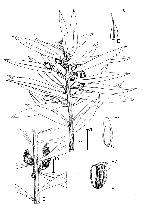Podocarpus archboldii
N.E. Gray 1958
Common names
"baula [Chimbu], jamekang [Tomba], juba [Nagen], kaibigltuga [Minj], morumba (Mendi), puling [Togoha], yamekange [Tomba]" (Van Royen 1979).
Taxonomic notes
The former var. crassiramosus Gray has been segregated as P. pseudobracteatus de Laubenfels (de Laubenfels 1988).
Description
"Trees up to 40 m, d.b.h. up to 100 cm. Bark grey, brown or pale brown, fairly smooth or slightly to strongly fissured, often longitudinally shedding. Inner bark brownish salmon. Sapwood straw. Wood brown, cream or pale brown. Branchlets stout, angular, terminal cone large, globose or ovoid, 4-6 by 3-5 mm, outer scales widely triangular, obtuse or long-acute or acuminate, upper ones apiculate, margin finely scarious, recurved. Leaves erect to patent, coriaceous, glabrous, brown or yellowish when young, dark green and glossy above, light green and dull below, crowded, narrowly lanceolate, 3-9.5(-13) by 0.5-1.1 cm, acute or acuminate, base narrowly cuneate, hardly marked against petiole, midrib narrowly prominent and sunken above, wider and rounded below, margin revolute. Petiole 0-2 mm long. Male flowers yellow, axillary, solitary, sessile or shortly stalked, peduncle short, angular, 8-10 by 2 mm, with 10-15 broadly ovate or orbicular-ovate scales, the latter 2.5-4.5 by 2.5-5 mm, crested, lower ones acuminate, apical ones apiculate or rounded, cone cylindric, 25-30 by 2-3.5 mm, microsporophylls oblong, 1.5-2 by 0.7 mm, rounded or obtuse, slightly scarious along margin, tip recurved, anther-cells ovoid, 1-1.5 mm long. Female cone solitary, axillary, globose, peduncles stout, 3-14 mm long, glabrous, ovule purplish green or green, shiny black or orange, 7-9 mm long, subtended by 2 deciduous, 2-3 mm long, acute bracts. Gruits green or glaucous, subglobose, 10-15 by 9-13 mm, pointed" (Van Royen 1979).
Distribution and Ecology
New Guinea. Regionally, is "[m]ainly found in the upper lowland regions to the upper montane areas, and occasionally found in the subalpine shrubberies, 800-3100 m. Flowers Jan. - Oct" (Van Royen 1979). Its local distribution includes (Van Royen 1979):
"WNG. Idenburo River area, Lake Habbema area.
"TNG. Lagaip River area, Wahag Valley, Kubor Range, Nondugl area, Keglsugl - Mt Wilhelm area, Mt Kerigomna, Marafunga, Omahaiga Valley, Mt Otto, Mt Sarawaket, Cromwell Mts, Bulolo-Wau-Edie Creek tract, Kaindi.
"PAPUA. Kaugel Valley, Mt Giluwe, Jalibu, Lake Kutubu, Wharton Range."
Remarkable Specimens
Ethnobotany
Observations
Remarks
Citations
Gray, Netta E. 1958. A Taxonomic Revision of Podocarpus, XI. The South Pacific Species of Section Podocarpus, Subsection B. Journal of the Arnold Arboretum 39:452. Available: Biodiversity Heritage Library, accessed 2023.01.08.
See also
The species account at Threatened Conifers of the World.


